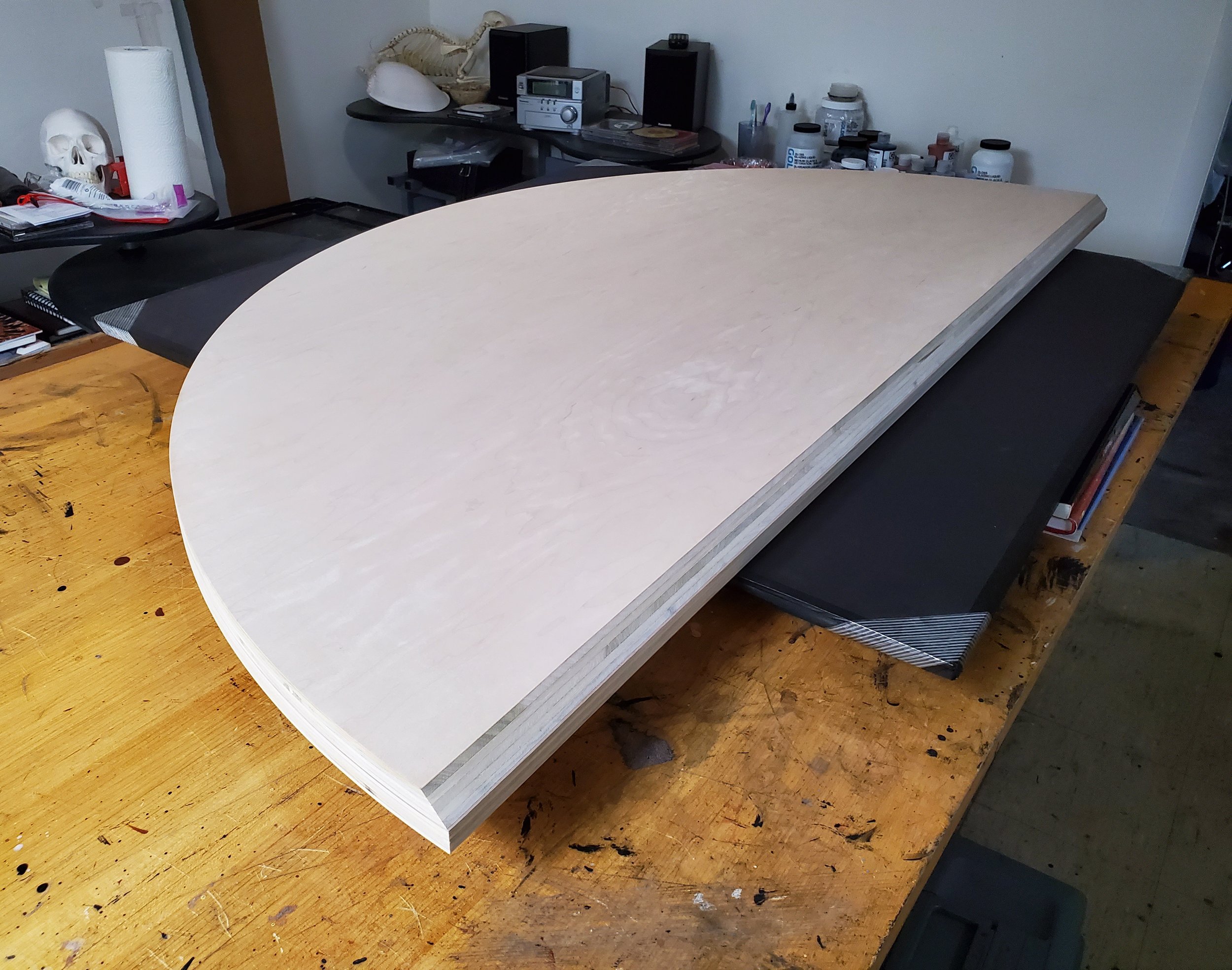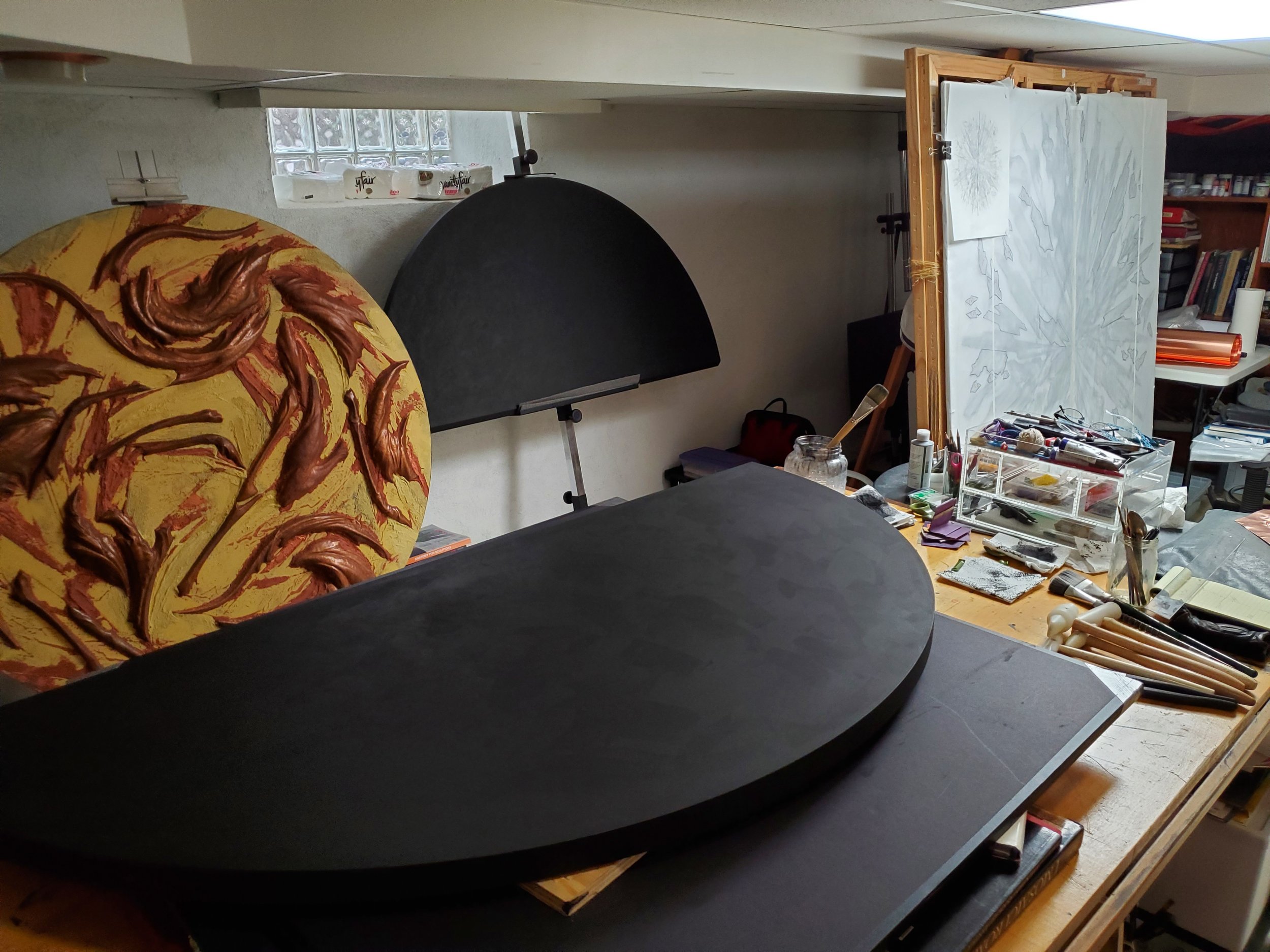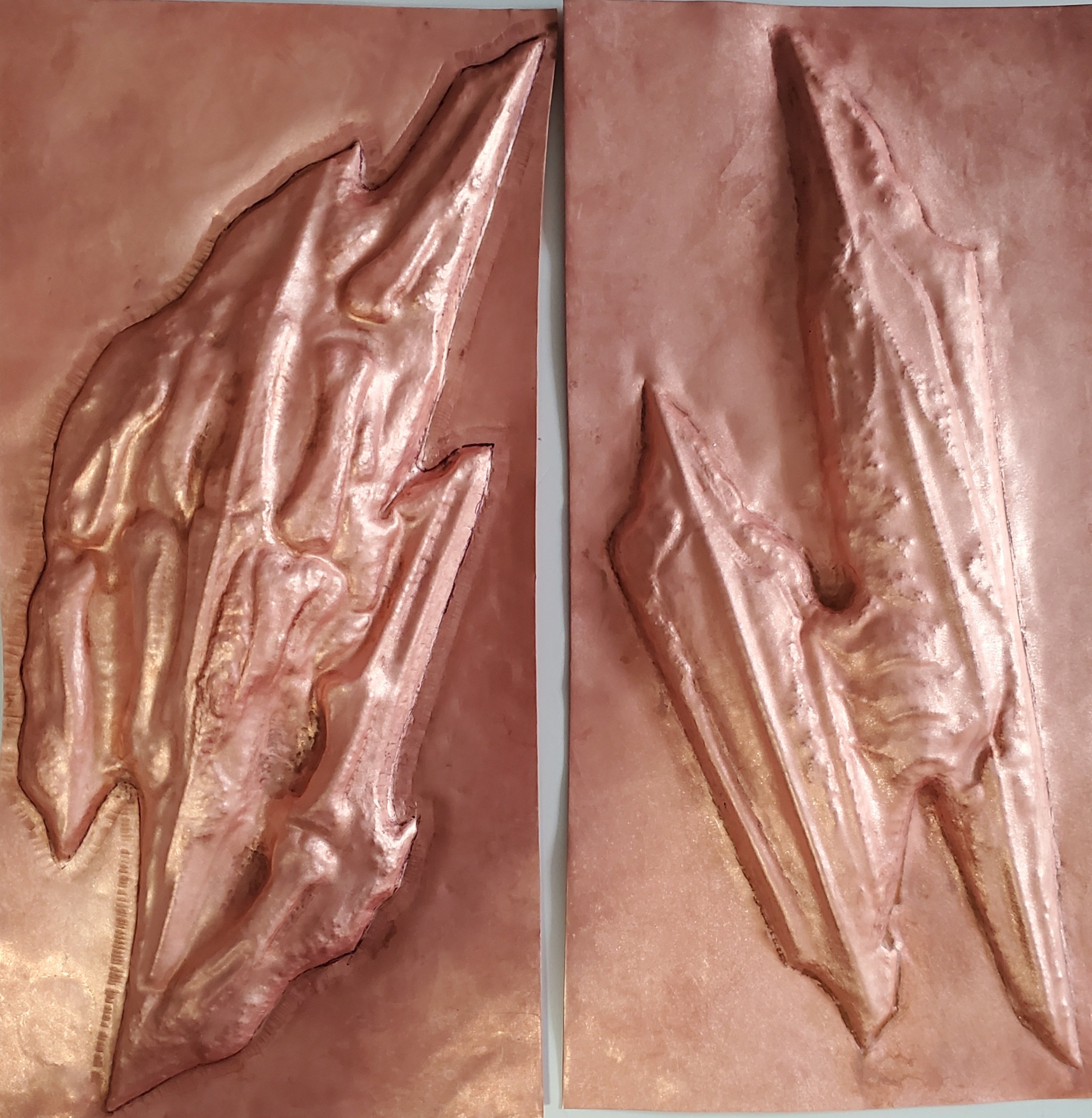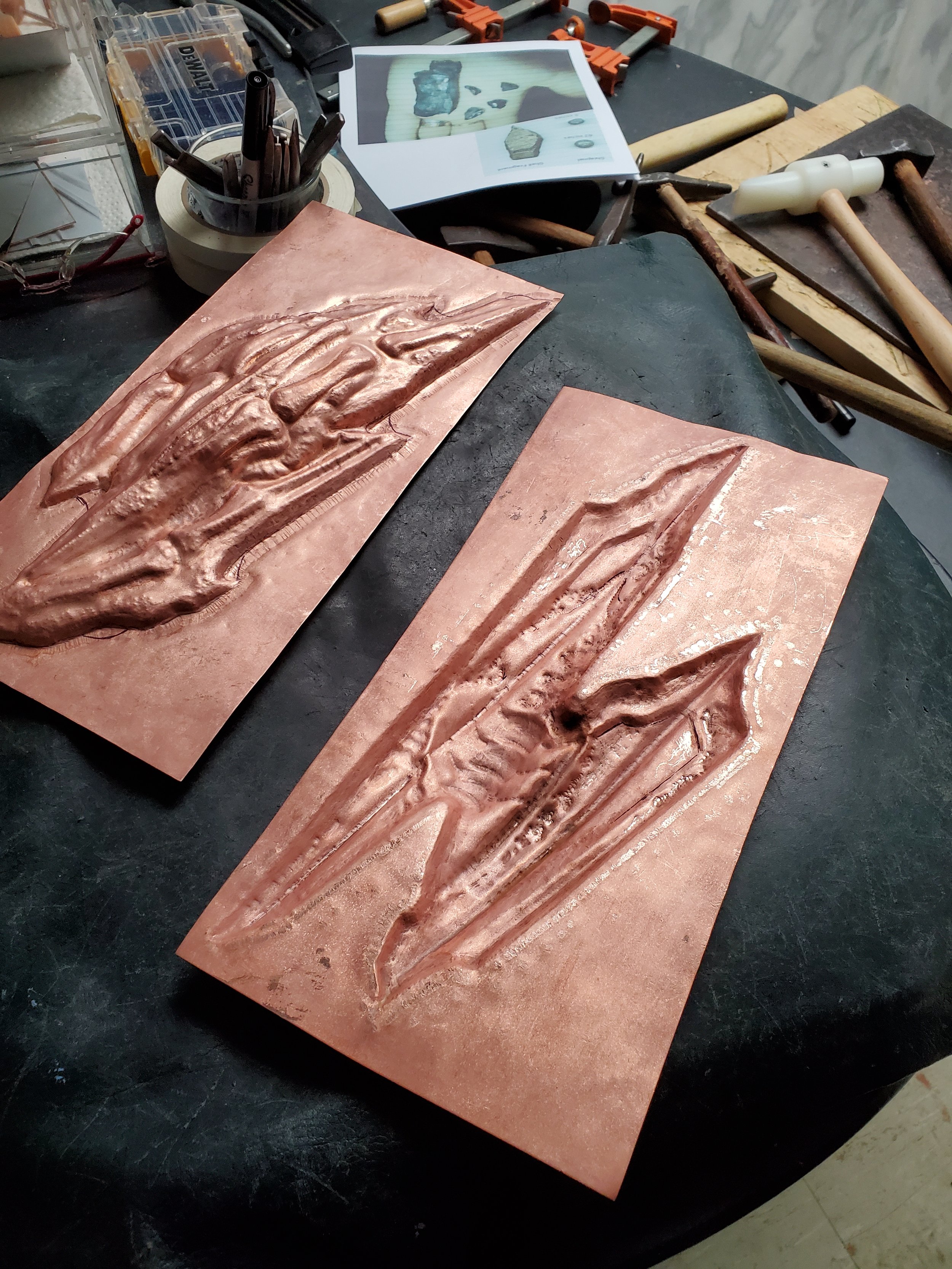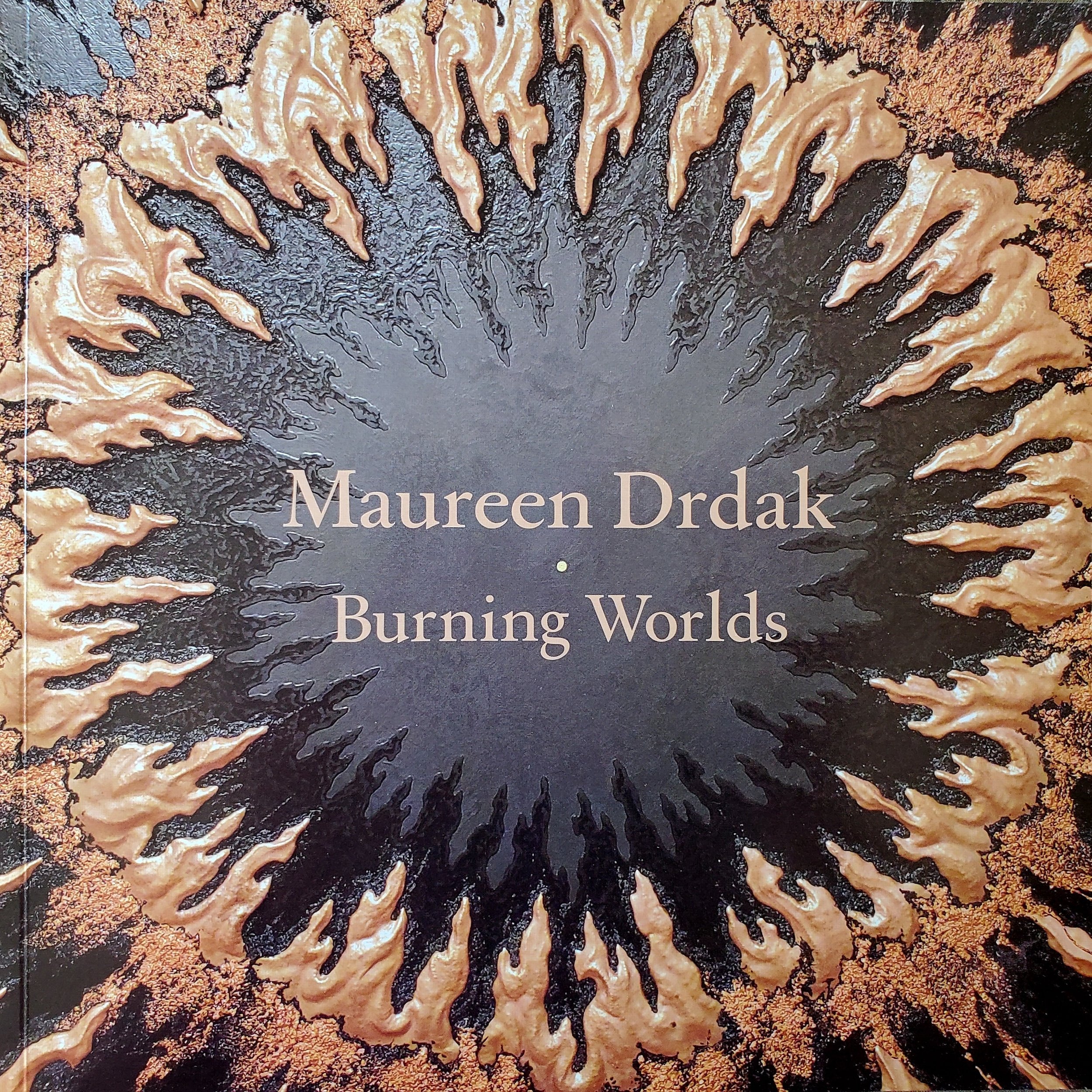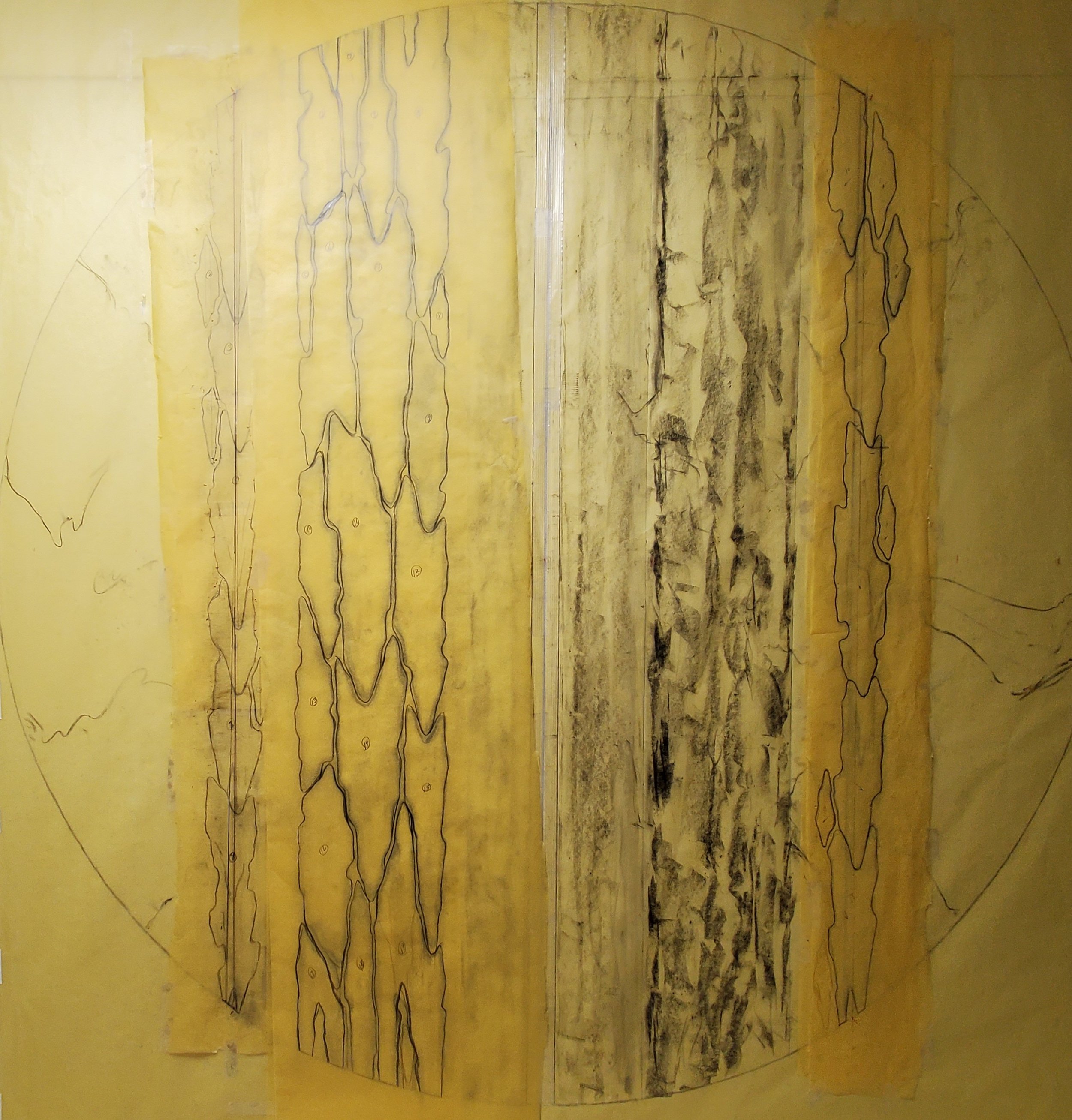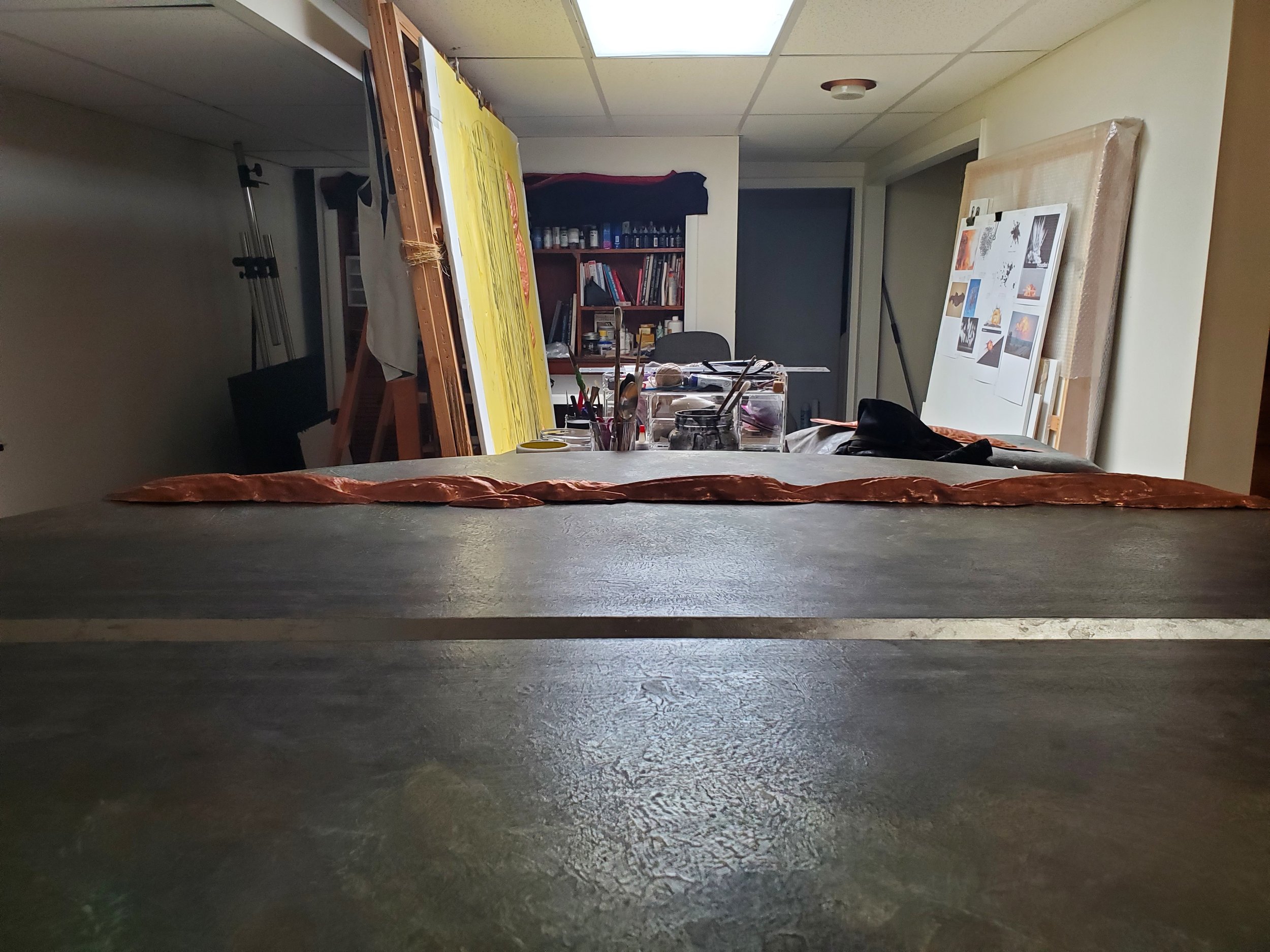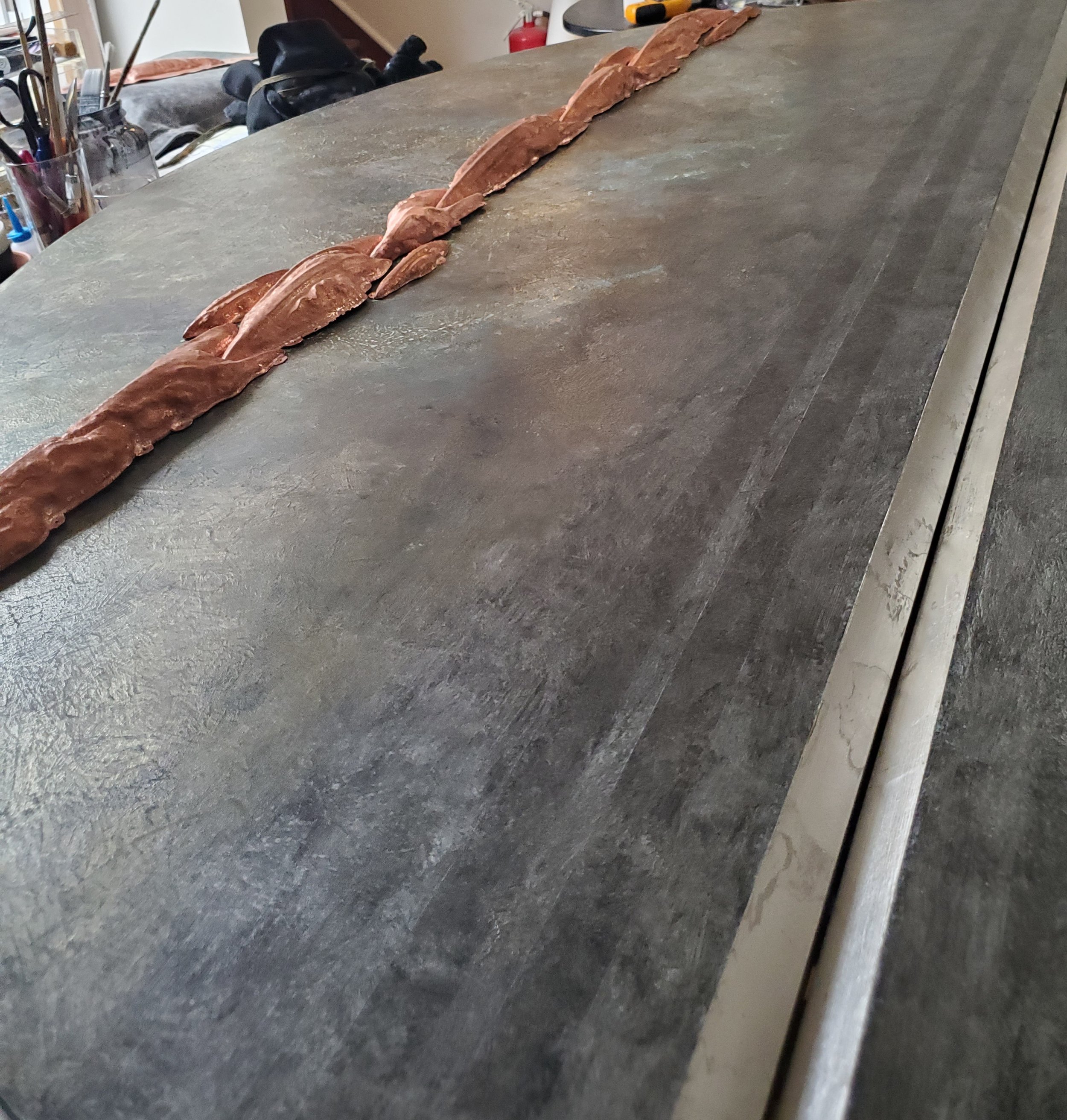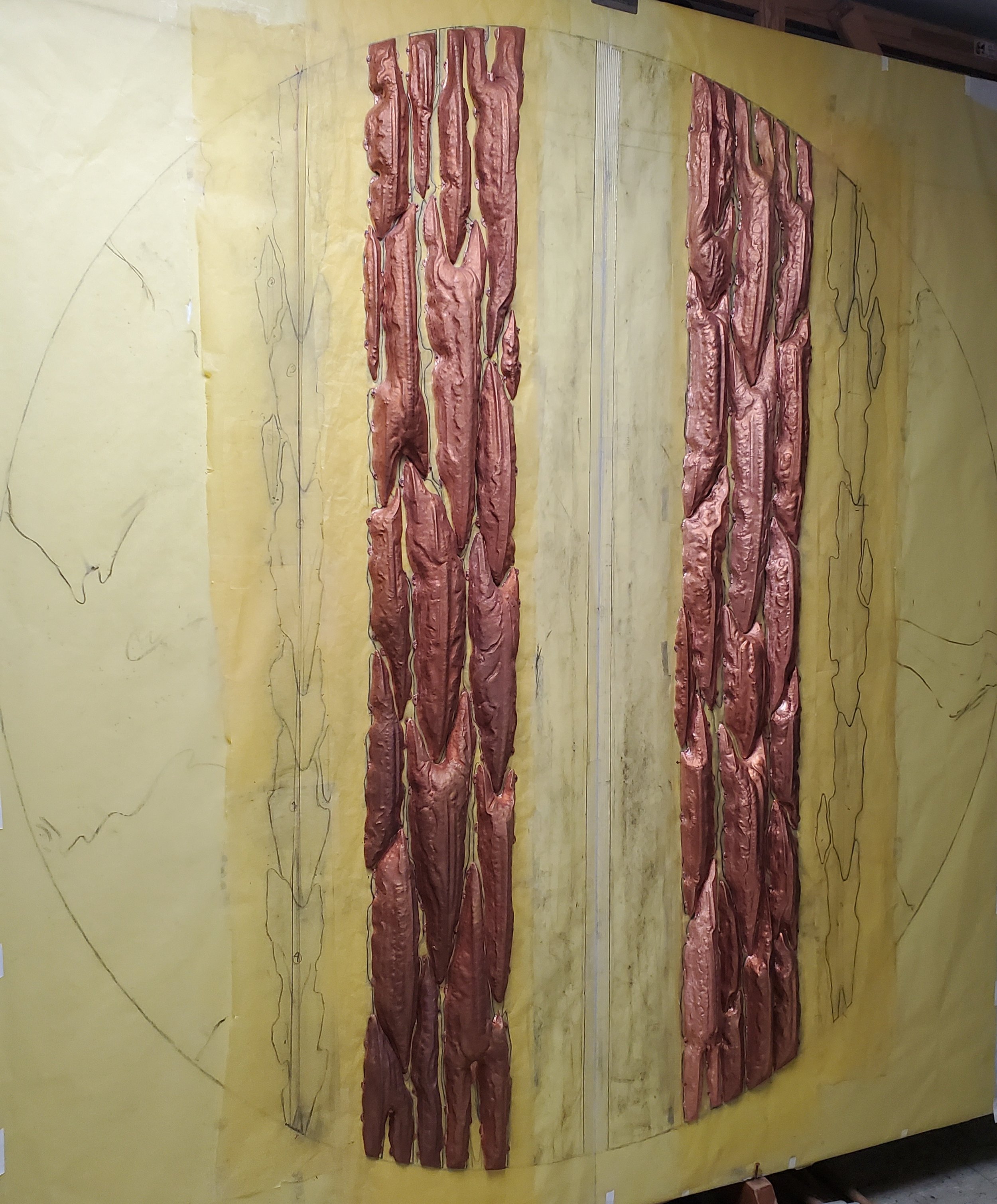Ardens Mundi
Ardens Mundi presents a collective portrait of a planet in violent turmoil— each anti-world prefiguring an apocalyptic face of global warming. A developing series of ten planned works, the series is envisioned as a sublime procession of nine “burning worlds,” each incarnating a specific impact of climate change, culminating with one monumental anchor work. Four completed works are presented here; the blackened furioso of firestorms, the flood of melting glaciers, the desiccation of drought, and the explosive force of bombogenesis. In its collective totality and heightened materiality, Ardens Mundi presents a portentous convergence of forms, processes and energies hurling towards environmental cataclysm—a manifest cri de coeur for universal action.
Intersecting history, culture, science, Ardens Mundi embodies the unique living history of the relationship and dialogue between two artistic traditions and practices. For the past decade Drdak’s work has employed the unique synthesis of repoussé metalwork and painting. This congress of materials—the first of its kind—was pioneered by Drdak and definitively established during her 2011 Fulbright research fellowship to Nepal where she studied with the finest living masters of this elite practice, the grandsons of the famed Kuber Singh Shakya of Patan, Nepal. Drdak is the first and only artist to date working with this unique congress of materials.
Ardens Mundi uniquely demonstrates the dynamic potential of traditional practices for contemporary applications; it provides both model and catalyst for contemporary artists in their exploration of the interstitial spaces between culture, process, and material. It explores and evidences the exciting expressive potential inherent in vanishing traditional aesthetic practices--and by extension—aids in their preservation.
ARDENS MUNDI installation, 2021, Gross McCleaf Gallery, Philadelphia,
Ardens Mundi 5, Diluvium 2024 Copper repoussé elements, mineral particle threads, palladium and abraded acrylic on 1.5 inch archival wood panel; total diameter five feet; two joining hemispheric panels each at 30 inches wide.
Ardens Mundi 4, Tempestatis 2019 Copper repoussé elements, mineral particle threads, and abraded acrylic on 1.5 inch archival wood panel, 48 inch diameter.
Private Collection.
Ardens Mundi 3, Dessico 2018 Copper repoussé elements, mineral particle threads, and abraded acrylic on 1.5 inch archival wood panel, 48 inch diameter.
Ardens Mundi 2, Conflatura 2018 Copper repoussé elements, mineral particle threads, and abraded acrylic on 1.5 inch archival wood panel, 48 inch diameter.
Private Collection.
Ardens Mundi 1, Inferno 2017 Copper repoussé elements, mineral particle threads, and abraded acrylic on 1.5 inch archival wood panel, 48 inch diameter.
Ardens Mundi 10, Ruptura in process. At 5.5 feet diameter, one of the two major anchor works planned for the series, AM 10 will comprise over one hundred repousse elements integrated within the painting field, and is anticipated to take over one and one half year to complete. Two wood panel hemispheres—sliced faces adjoining to form the unified visual field—concretize the multiplying cleavages erupting across the planet. Ardens Mundi 10 will speak with explosive force to global rupture—societal, political, military and ecological—the tenth face of the burning worlds of climate change.
Ardens Mundi 5, Diluvium. Total diameter five feet; two joining hemispheric panels each at 30 inches wide.
At 5 feet diameter, first of the two major anchor works planned for the series, AM 5 speaks to the growing phenomena of flood induced landslide, typified by, but not limited to, glacial lake outburst flooding (GLOF). Diluvium, is the first anchor work, and will directly face Ardens Mundi 10, Ruptura, the climactic work, of the Ardens Mundi cycle. The foundational substrate shown here with palladium leaf bevels.
WRITINGS
RISKY BEAUTY: Aesthetics and Climate Change
The Mother Earth metaphor can be extended when viewing Maureen Drdak’s Inferno. The title, combined with the tondo (round form) expresses a planet on fire, one aspect of the Greek Goddess Gaia, who was both bountiful and monstrous. When controlled, plundered, and defaced by men, she suffered greatly—” And monstrous Gaia was burning all over with an ineffable blast and melted like tin heated beneath the skill of craftsmen in bellowed crucibles or iron…subdued in the mountain glens by blazing fire…” (Hesiod). The warm hues, the glint of gold, the amalgam of textures, and the swirling shapes are magnets for our eyes and conduits to our emotions. Drdak’s painstakingly--crafted mixture of metals, minerals, and paint is like a witch’s cauldron, a brew of unimaginable heat and toxicity. Yet the unimaginable is here—frequent record-breaking heat waves and uncontrollable wildfires in densely populated regions. Looking at repousse with a contemporary ecological eye, we link the metal with industrial processes that pollute and contribute to global warming. The life-giving manifestations of Gaia have disappeared.
Cynthia Haveson Veloric PhD.
MAUREEN DRDAK’S ARDENS MUNDI
Maureen Drdak’s work has fascinated me for more than a decade. I have seen her explore techniques and ideas in ways both visually stunning and intellectually rooted in ancient and contemporary traditions. Drdak’s work is at its core representative of contemporary abstraction with a strong sense of the communicative power of physicality. Tied through her studies to the traditions of Nepalese copper repousse artistry, which she has pursued with unrestrained dedication and passion, she has developed a selective mastery of the methods of her mentors in Nepal. As prophetic statement her series, Ardens Mundi, speaks to the destructive impacts of human-caused climate change, the forms of which immediately call to mind many centuries of imagery tied to the Hindu deity Shiva’s climactic destruction of the world through a frenetic dance of fire and devastation. With their twisting, spiraling energies they reference mandalas, the meditative tools used in the Buddhist spiritual practices common in the Himalayan region, tracing the inevitable path from birth to death and back again as the wheel of life turns on and on. The eye follows each Drdak’s circular mandalas into the center and back out to the periphery in an unending display of the apocalypse at the core of each work.
Repousse serves a key role as the most prominent and visually compelling element within each burning world. Copper incarnates the emphatic form and energy contained withing their spherical constraints. Thick applications of minerals and pigments provide textures and visual cues reading as earth, as sky, as land ablaze in the unstoppable conflagration. These maelstroms, like the mandala, map our experience in the face of these natural forces to reveal cause and effect, and pointing to the horrific future we have brought upon ourselves.
Living in California and facing head-on the environmental disasters Drdak depicts, I find myself transfixed by these swirls of fire, of drought, and of never-before-seen storms. These mandalas show me the path that lies ahead. This prophetic imagery speaks to an inescapable future. While I see in these works elements of Nepalese spirituality, they are equally reflective of Drdak’s personal history. Trained in Philadelphia and widely traveled in Europe and the Middle East, Drdak is grounded within her own heritage and its traditions. What may be mandalas to me are also the horsemen of our current apocalypse. Drdak’s aesthetically sumptuous, dynamic displays of materials give these manifestations of impending doom just the right amount of sex appeal so that we welcome them in the door. It is then that their full impact can be felt and their deadly job can commence. Durer’s horsemen rode in from the sky rich with the imagery of death; Drdak’s horsemen spin and twist their fiery slashes of destruction conveying the devastating power we have unleashed and that we all one day soon will feel cutting, burning, drowning all that we cherish and desire to retain.
Robert Mintz Ph.D., Deputy Director, Art & Programs, Asian Art Museum of San Francisco








